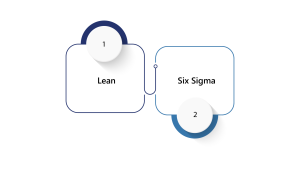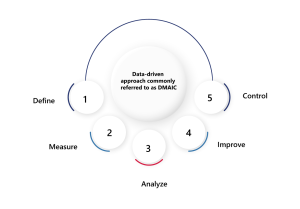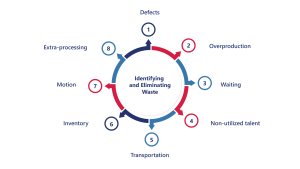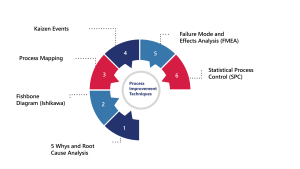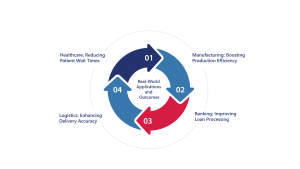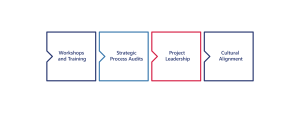Enhancing Operational Efficiency through Lean Six Sigma
In a competitive global marketplace, operational efficiency is a cornerstone of success. Companies are under constant pressure to do more with less—less time, less cost, and fewer resources—while improving quality and customer satisfaction. Lean Six Sigma, a powerful methodology that blends the waste-reduction focus of Lean with the defect-elimination approach of Six Sigma, has emerged as a proven solution to these challenges.
In this guide, we explore how Lean Six Sigma empowers organizations to optimize performance, foster a culture of continuous improvement, and achieve measurable business results —making it a key part of any operational excellence consulting strategy.
Understanding Lean Six Sigma Principles
Lean Six Sigma is a hybrid methodology that combines two well-established approaches:
- Lean: Originating from the Toyota Production System, Lean focuses on maximizing customer value while minimizing waste. Its goal is to create more value with fewer resources.
- Six Sigma: Developed by Motorola and popularized by GE, Six Sigma aims to improve process quality by identifying and eliminating the causes of defects and minimizing variability.
Together, Lean Six Sigma emphasizes both speed and accuracy—delivering better outcomes faster and more consistently. The framework follows a structured, data-driven approach commonly referred to as DMAIC:
- Define: Clarify the problem and customer expectations.
- Measure: Quantify current performance.
- Analyze: Identify root causes of inefficiencies or defects.
- Improve: Develop and implement solutions.
- Control: Sustain improvements through standardization and monitoring.
This systematic methodology enables teams to diagnose inefficiencies, validate solutions with data, and implement changes that stick —hallmarks of high-impact process improvement consulting.
Identifying and Eliminating Waste
At the heart of Lean Six Sigma is the relentless pursuit of waste elimination. In Lean terminology, waste (known as muda) refers to any activity that consumes resources without adding value to the customer. There are 8 classic types of waste:
- Defects: Rework or scrap due to quality issues.
- Overproduction: Producing more than needed or too early.
- Waiting: Idle time caused by delays or bottlenecks.
- Non-utilized talent: Underused employee skills and ideas.
- Transportation: Unnecessary movement of materials.
- Inventory: Excess raw materials, WIP, or finished goods.
- Motion: Inefficient movements by people or machines.
- Extra-processing: Unnecessary steps that don’t add value.
Lean Six Sigma training typically begins by mapping the current process and identifying areas of waste using tools such as Value Stream Mapping (VSM), process flow charts, and spaghetti diagrams. These visualizations make it easier to pinpoint inefficiencies and prioritize improvement opportunities.
For example, a manufacturing plant may discover that overproduction and inventory buildup are straining storage capacity and tying up capital. By redesigning production scheduling, they can reduce cycle times and free up working capital through more effective operations consulting services.
Process Improvement Techniques
Lean Six Sigma equips practitioners with a diverse set of tools and techniques to streamline operations and enhance process quality. Some key methods include:
1. 5 Whys and Root Cause Analysis
Simple yet powerful, the 5 Whys technique helps teams dig deep into the root cause of a problem by asking “Why?” multiple times. This prevents superficial fixes and drives lasting improvements.
2. Fishbone Diagram (Ishikawa)
Also called a cause-and-effect diagram, this visual tool categorizes potential causes of problems to uncover systemic issues in areas such as people, methods, machines, materials, and environment.
3. Process Mapping
Creating detailed flowcharts of current workflows helps visualize inefficiencies, handoffs, delays, and redundancies.
4. Kaizen Events
Kaizen, meaning “continuous improvement” in Japanese, refers to short-term focused workshops that involve cross-functional teams solving specific problems quickly.
5. Failure Mode and Effects Analysis (FMEA)
FMEA systematically assesses potential failure points in a process and ranks them based on severity, occurrence, and detection, allowing teams to prioritize risk mitigation.
6. Statistical Process Control (SPC)
By monitoring process performance using control charts, SPC helps detect variation early, enabling proactive correction before defects occur.
By applying these techniques within the DMAIC framework, organizations can design processes that are not only efficient but also resilient and scalable —driving measurable results through structured continuous improvement strategies.
Lean Six Sigma Training and Certification Paths
Lean Six Sigma is accessible to professionals at all levels through structured training and certification programs. These are often color-coded by belt levels, much like martial arts, signifying increasing levels of expertise:
● White Belt
An introduction to Lean Six Sigma principles, intended for individuals who need basic awareness to support improvement efforts.
● Yellow Belt
Provides a working knowledge of Lean Six Sigma tools and the ability to participate in project teams.
● Green Belt
Geared toward professionals who lead smaller projects or support larger ones. It includes deeper training in statistical tools, DMAIC methodology, and team facilitation.
● Black Belt
Reserved for experienced practitioners who lead complex projects, mentor Green Belts, and drive strategic initiatives. Black Belts are experts in data analysis, project management, and change leadership.
● Master Black Belt
The highest level of certification, Master Black Belts provide strategic oversight, coach Black Belts, and align projects with business objectives.
Many reputable institutions offer Lean Six Sigma certifications, including ASQ (American Society for Quality), IASSC (International Association for Six Sigma Certification), and universities and corporate academies. Online platforms such as Coursera, Udemy, and LinkedIn Learning also provide flexible, self-paced options.
These programs support broader business goals like business optimization consulting, helping organizations scale process improvements across departments.
Real-World Applications and Outcomes
Lean Six Sigma has been successfully implemented across industries—from manufacturing and healthcare to finance, logistics. Its applications tie directly into goals common among strategy consulting firms, such as reducing costs, improving quality, and enhancing productivity.
Examples include:
● Healthcare: Reducing Patient Wait Times
A major hospital used Lean Six Sigma to improve its emergency department workflow. By analyzing patient flow, eliminating redundant paperwork, and reorganizing staffing patterns, the hospital reduced average wait times by 40% and improved patient satisfaction scores.
● Manufacturing: Boosting Production Efficiency
An automotive supplier applied Lean Six Sigma to address bottlenecks in its assembly line. Through root cause analysis and equipment upgrades, the team increased output by 25% and reduced defects by 60%, saving millions annually.
● Banking: Improving Loan Processing
A financial institution struggling with slow mortgage approvals utilized Lean Six Sigma to streamline the underwriting process. By eliminating unnecessary reviews and digitizing documentation, processing time dropped from 20 days to 7, boosting customer satisfaction and revenue.
● Logistics: Enhancing Delivery Accuracy
A global logistics firm implemented Lean Six Sigma to reduce late deliveries. Data analysis revealed errors in routing and loading. Standardizing processes and training drivers led to a 95% on-time delivery rate—up from 83% within six months.
These examples underscore the versatility and impact of Lean Six Sigma in solving real business challenges and driving measurable ROI.
CCO Consulting: Empowering Excellence through Lean Six Sigma
At CCO Consulting, we specialize in driving operational excellence consulting across industries. Our services include:
- Workshops and Training: Customized certification programs for teams at every level, from White Belt to Black Belt.
- Strategic Process Audits: We assess current-state operations, identify inefficiencies, and design improvement roadmaps.
- Project Leadership: Our certified Lean Six Sigma experts lead high-impact projects that deliver fast, sustainable results.
- Cultural Alignment: We help build a culture of continuous improvement, empowering staff to own and sustain change.
Whether you’re seeking to reduce costs, boost customer satisfaction, or accelerate innovation, we help unlock performance potential across your enterprise, serving as your partner in cost reduction consultants, business operations consulting firm initiatives, and strategic growth.
Conclusion
Lean Six Sigma isn’t just a methodology—it’s a mindset. By focusing on eliminating waste, reducing variability, and empowering employees with integrating tools for operational efficiency solutions, it helps businesses stay agile in a fast-changing world. The approach is structured, data-driven, and results-focused—making it a valuable asset in today’s complex, fast-moving business landscape.
In this guide, we explored Lean Six Sigma principles, tools, training paths, and real-world applications. Whether you’re starting small with a single department or launching an enterprise-wide initiative, Lean Six Sigma provides a clear path to excellence.
Partner with CCO Consulting to bring these principles to life—and watch operational excellence become your competitive advantage.

